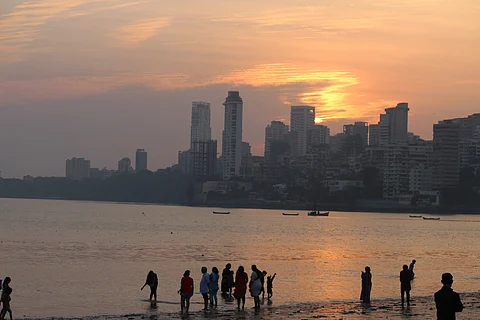
- Destinations
- Experiences
- Stay
- What's new
- Celebrating People
- Responsible Tourism
- CampaignsCampaigns
- SubscribeSubscribe
- Buy Now

It has the highest rents in India. The commute times and traffic could make even the strongest cry. And yet, if a survey is to be believed, Mumbai is the happiest city in the country. Go figure. According to Time Out’s City Life Index 2025, India’s bustling financial capital has officially been crowned the Happiest City in Asia, beating destinations like Beijing, Shanghai, Chiang Mai, and Hanoi.
The finding may come as a surprise to many residents who grapple daily with soaring living costs and gridlocked traffic of Mumbai. Yet, it seems that the city’s energy, opportunities, and cultural vibrancy continue to inspire optimism among its people.
Of course, happiness is a deeply personal measure — what lifts one person’s spirits may leave another unmoved. Still, numbers can reveal patterns. In the Time Out City Life Index 2025, over 18,000 people across Asia were asked how happy they feel in their cities, and they shared candid insights about what it feels like — not just their opinions on culture and food, but on life.
The survey asked participants to rate their hometowns across several key aspects — from culture, nightlife, and food to affordability and overall quality of life. They also responded to five statements measuring how happy their city makes them and whether the people around them seem positive and content.
An overwhelming 94 percent of Mumbaikars said their city makes them happy. Nearly nine in ten reported feeling happier in Mumbai than anywhere else, while a similar proportion said locals generally seem cheerful. Most strikingly, 87 percent of respondents believe that happiness in the city has grown in recent years.
Following closely behind Mumbai are Beijing and Shanghai, where 93 percent and 92 percent of locals, respectively, say their city makes them happy. Both Chinese megacities scored high on safety, convenience, affordability, and culture. They’ve also become magnets for younger generations, offering a dynamic mix of innovation, modern living, and forward-thinking urban design that keeps residents optimistic about the future.
Not far behind, Chiang Mai in Thailand and Hanoi in Vietnam round out the top five. Each city reported that 88 percent of residents feel happy where they live. Hanoi edged slightly ahead when it came to finding joy in everyday life, while both cities were praised for their greenery, relaxed pace, and tight-knit sense of community — offering a refreshing contrast to the intensity of Asia’s larger metropolises.
Some of Asia’s busiest cities didn’t make the top of the happiness list. Seoul, Singapore, and Tokyo ranked lower, with just 70 percent of Tokyo residents saying their city brings them joy. Experts attribute this to long working hours, high-pressure careers, and the relentless pace of urban life. To restore balance, they recommend simple escapes: a walk in a park, a soak in a traditional bathhouse, or a weekend retreat into nature — small moments that can brighten city living.
In 2025, the Time Out top ten happiest cities in Asia are: Mumbai, Beijing, Shanghai, Chiang Mai, Hanoi, Jakarta, Hong Kong, Bangkok, Singapore, and Seoul.
The respondents were asked about culture, nightlife, food, walkability, affordability and quality of life, among other things. They were also asked about happiness. Despite their differences in size, culture, and lifestyle, these cities share a key trait: a strong sense of community and joy in everyday life.
(With inputs from various sources.)
Which city is the happiest in Asia in 2025?
Mumbai has been ranked the happiest city in Asia according to Time Out’s City Life Index 2025.
How is city happiness measured in Asia?
The survey evaluates factors like culture, nightlife, food, affordability, quality of life, and residents’ overall sense of happiness and positivity.
Which other cities rank high for happiness in Asia?
Beijing, Shanghai, Chiang Mai, and Hanoi are among the top five happiest cities, each scoring high in community, lifestyle, and daily joy.
Why do some major cities rank lower on happiness?
Cities like Tokyo, Seoul, and Singapore rank lower due to long working hours, high-pressure careers, and fast-paced urban life. Experts recommend parks, nature, and leisure activities to improve well-being.
What makes a city truly happy for its residents?
True urban happiness comes from community, cultural engagement, daily experiences, and a sense of belonging — not just infrastructure or income.
